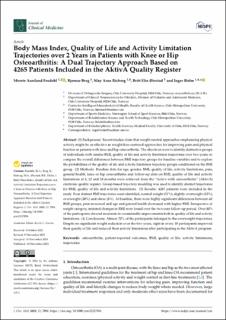| dc.description.abstract | Background: Recent studies claim that weight-neutral approaches emphasizing physical activity might be as effective as weight-loss-centered approaches for improving pain and physical function in patients with knee and hip osteoarthritis. The objectives were to identify distinctive groups of individuals with similar BMI, quality of life and activity limitation trajectories over two years, to compare the overall differences between BMI trajectory groups for baseline variables and to explore the probabilities of the quality of life and activity limitation trajectory groups conditional on the BMI group. (2) Methods: Baseline data for age, gender, BMI, quality of life, activity limitations, pain, general health, knee or hip osteoarthritis and follow-up data on BMI, quality of life and activity limitations at 3, 12 and 24 months were retrieved from the “Active with osteoarthritis” (AktivA) electronic quality register. Group-based trajectory modeling was used to identify distinct trajectories for BMI, quality of life and activity limitations. (3) Results: 4265 patients were included in the study. Four distinct BMI trajectories were identified, normal weight (31%), slightly overweight (43%), overweight (20%) and obese (6%). At baseline, there were highly significant differences between all BMI groups, pain increased and age and general health decreased with higher BMI. Irrespective of weight category, minimal changes in BMI were found over the two-year follow-up period. Over 80% of the participants showed moderate-to-considerable improvements both in quality of life and activity limitations. (4) Conclusions: Almost 70% of the participants belonged to the overweight trajectories. Despite no significant weight reduction over the two years, eight in every 10 participants improved their quality of life and reduced their activity limitations after participating in the AktivA program. | en_US |

